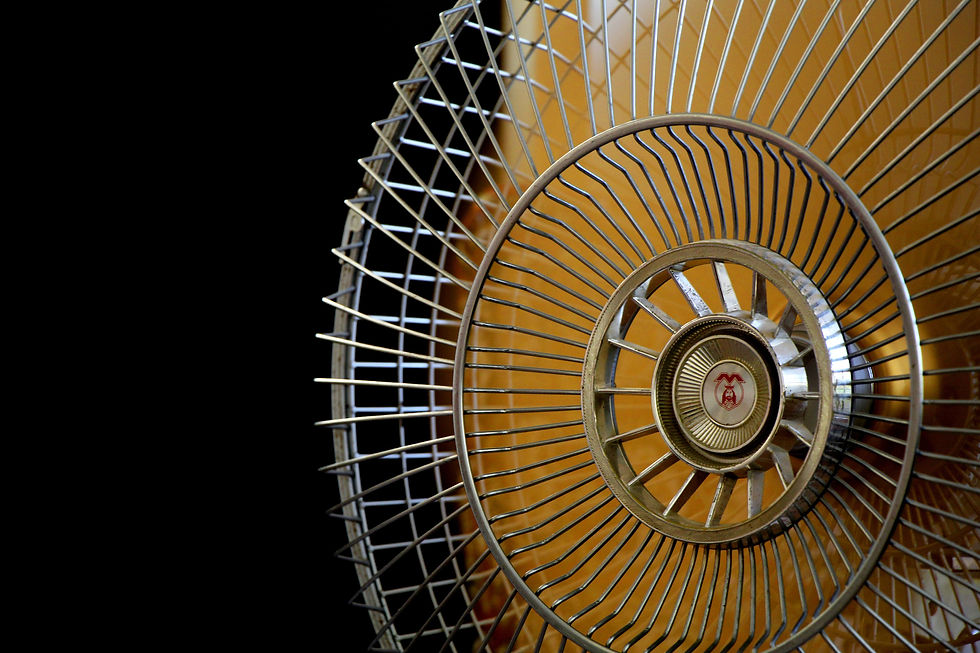Should You Repair Or Replace Your A/C?
- Christian Domingo
- Sep 14, 2022
- 7 min read
Most people won’t examine their property’s air quality much further than “boy it’s hot, better get an air conditioner”. While this is a wonderful way to improve the quality of your life, it’s not a one-size-fits-all solution. Air quality is one of the biggest contributors to our daily comfort, and one that is often overlooked. Current cooling systems on the market vary in effectiveness, longevity, and efficiency, with the quality margin between models growing larger and larger as technology continues to progress. What might be okay today could be subpar in a month, or obsolete in a year. Luckily, if you’re looking for ways to upgrade the quality of your air conditioning, keep reading - we’ve got you covered.

Image by ElasticComputeFarm from Pixabay
Generally, the simplest way to determine whether to repair or replace your air conditioning unit is to multiply the cost of repairs by the age of the unit. While the average lifespan of a furnace is 15 to 20 years, if the sum of your calculations is over $5000, it may be time to consider a new unit. Even an HVAC system that is only 8 to 10 years old can use up twice the electricity of a low-end unit. This is due to a concept called Seasonal Energy Efficiency Ratio (SEER) that relates to the amount of energy needed to provide a specific cooling input. Prior to 2006, the standard SEER for A/C units was 10, but today that minimum is now 13, as mandated by federal law. As a result, the average electrical consumption and cooling bills associated with modern cooling units is 30% lower than previous years.
But what does this mean for your property? Well, installing a 13 SEER unit in an 1,800 square-foot house will cost around $3,000 to $4,000. You can also multiply your energy savings by investing in a 16 SEER unit - thus reducing 60% of cooling expenses compared to a 10 SEER unit - but at an average cost of $5-6,000, these are a pricier option. However, A/C systems with a SEER of 14.5 or higher are eligible for ENERGY STAR designation, which certifies them as meeting a high standard of energy efficiency. This means that they can qualify for government or utility company rebates when being retrofitted into a space. That said, Canadians probably won't need an A/C system over 20 SEER, as the return on investment doesn't stack up to the initial costs. In these instances, it's up to you to weigh the short-term expenditures against the long-term savings, but speaking to an HVAC expert (like say, us) will make that decision much simpler.

Keep in mind that 2/3rds of the year still looks like this up here.
Photo by Allison Batley on Unsplash
Another thing to consider is the size of your air conditioning unit. In the HVAC industry, air conditioning is measured in tons - this isn't to do with the weight of the unit, but rather the amount of British Thermal Units (BTUs) of heat that an air conditioner can remove. The basic measure of air conditioner tonnage is the amount of heat that will melt a pound of ice back into water. A pound of ice at 32°F requires 143 BTUs to melt - multiplying 143 BTUs by 2,000 pounds results in 286,000, the amount of BTUs needed to melt one ton of ice. This number is then contextualized within a 24-hour span, meaning that 286,000 is divided by 24, resulting in 11,917 BTUs. Rounded up to 12,000, this means that one ton of air conditioner capacity is equivalent to 12,000 BTUs of heat removal per hour.

Don't worry, the math part is over now.
Photo by Edward Jenner
Now many traditional HVAC installers use a rough estimate to size equipment, such as one ton per 400-600 square feet. This, however, can lead to systems that are too big for a space being installed. These larger systems cost more and also work too efficiently; cooling a room quicker than intended leads to more frequent on/off cycles, which wears out components, uses more electricity, and is less effective at dehumidifying the air. This is why good contractors use load calculations in their bids, which take into account factors like the number of windows on a property, the thickness of its insulation, and the amount of sun a building gets. This helps narrow down the exact tonnage needed in an air conditioning unit as well as determining the amount of cool air that each room in a building needs.
That said, if your air conditioner is less than 5 years old, you’re more than likely okay to hold onto it for a while longer. Of course, this is just a basic method for determining the health of your HVAC system – below, we’ve highlighted several other criteria to consider when looking to upgrade, fix, or replace your air conditioner or heating unit.
Wear, Tear, and Unconditioned Air
While it might be a little tricky to figure out whether your A/C is to working properly, it’s usually pretty easy to tell when it isn’t. A broken air conditioner can be easily identified by an uptick in squealing, grinding, or grating within the unit, hot air being blown through the vents and unevenly distributed around the space, and of course, the beating that your wallet takes once the energy bills come knocking. One thing to look out for in particular – not that it would be easy to miss – is a burning or moldy smell coming from the unit. While a burning smell is obviously a cause for concern in any part of the home, when it comes from an A/C unit it’s often indicative of wiring issues or moisture buildup. Poor ventilation can also cause more dust to appear around your space, particularly if you have pets (consider this next time you’re stumped over how fur ends up wafting to the top of your fridge). Furthermore, broken A/C’s increase the humidity inside a space, and combined with moisture leakage, this can cause mold to form in an around the unit, as well as anywhere along the ventilation network where humidity and moisture might collect. Left unchecked, this can cause issues for people who are allergic or sensitive to mold, including congestion, wheezing, and red, itchy eyes and skin. Ever found yourself wondering where those sudden “seasonal” allergies came from? The answer might be in your walls.

Although if you're a Jackson Pollock fan, you're in luck.
Photo by Andrew Small on Unsplash
There are also factors outside of the air conditioning unit that need to be considered. Even if you have a top of the line unit installed in your property, the ductwork surrounding it could be letting out up to 30% of the cooler air before it can be circulated around your space. This is why it's important to not only let your technician run a diagnostic on your A/C, but also perform a duct-leakage test to measure how much air is escaping from your system. Depending on their findings, you may have to consider either sealing or replacing the ductwork entirely. A property that is poorly insulated to begin with will also put a lot of strain on an older air conditioner, and having a certified technician look over the infrastructure of your property could allow your air conditioning unit to operate effectively for a few more years, or cut your cooling needs enough that you can switch to a smaller unit, thus lowering your upfront energy costs significantly. Our HVAC technicians can accomplish this by sealing cracks or gaps along the outer walls of your property, as well as blowing insulation into the walls, either of which will considerably improve your heating and cooling costs moving forward.
R22 and You
Though your average HVAC unit should be serviceable for at least 15 to 20 years, units that are over 10 years old often run on a refrigerant called R-22 Freon. When released into the air outside, R22 depletes the ozone layer and contributes significantly to global climate change. In fact, according to a study by the EPA, R22 emissions have been a direct cause in a hole in the ozone over the South Pole – essentially, we've been stealing all our cool air from Antarctic penguins.

And they’re only going to take so much before they snap.
Photo by Jean van der Meulen
In 2020, the EPA announced that R22 production would be halted indefinitely, and that only recycled and stockpiled quantities would be used moving forward. By 2030, their goal is to completely ban the production and import of R22, along with all other HCFCs. What does this mean for you? Well firstly, it means that even if your older-model air conditioner has run smoothly so far, it still won’t be long before it becomes obsolete based purely on the refrigerant it uses. Secondly, as R22 prices will only rise as supply decreases, it may be beneficial to look into replacing your unit for a more modern model sooner rather than later. Currently, completely refilling your unit with R22 can cost anywhere from $180 to $600 – comparatively, other types of refrigerants (such as R410-A, its most common replacement) only cost about $100 to $320 to refill a unit. Installation costs should also be considered – R22 will cost about $90 to $150 per pound to install, while the aforementioned R410-A only costs $50 to $80.
Furthermore, air conditioners that run on R22 can’t be retrofitted to run on an alternative, as their hardware is incompatible with other refrigerants. Instead of paying thousands of dollars repairing a unit that may only have a few years left in it, consider buying an eco-friendlier model instead – the upfront installation costs might be high, but you’ll be saving your wallet and your planet a lot in the long run.
The Feel-Good Factor
Of course, at the end of the day, the decision between repair and replacing your air conditioner often comes down to comfort. Walking into a well-ventilated space just feels good. On these mid-summer days, especially, it becomes the difference between a room in an office building and an oasis in the desert. Picture it now - it’s August, the sun is beating down above you, the concrete below you has all but melted the soles off your shoes, and you step into a building hoping for some relief, only to find the air is as thick as soup and about as hot as well.
That’s why when it comes to your air conditioning unit, we always recommend a modern approach. Through innovations like smart thermostats and alternative cooling systems, it’s never been simpler and more accessible to create the perfect temperature for your property. It’s not just technology that’s changing either, the Earth itself is a much different place than it was when your air conditioner may have first been installed.

A very different place for some of you.
Fortunately, we’ve managed to adapt to these changes. An HVAC solution that can meet the needs of both your property and the environment around it is just a bit of research and a phone call away. Still unconvinced? Give us a call today and our team of certified HVAC technicians will show you just how easy it is to upgrade your air quality. We’re not full of hot air, and your property shouldn’t be either.




If you consider doing regular maintenance of your HVAC unit then you will never face early replacing your HVAC unit. So, it's better to hire an AC Repair expert to regularly service your heating and cooling unit.